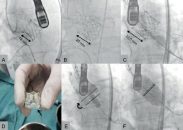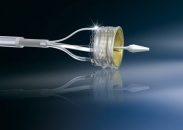Transcatheter aortic valve replacement (TAVI) with the new generation balloon expandable valve is at least as good as surgery in intermediate risk patients with severe symptomatic aortic stenosis. For those that can be accessedfemorally, TAVI seems even better than surgery. In all, 2032 intermediate risk patients were randomized in 57 centers to TAVI with Sapien…
The SAPIEN 3 Valve Resulted Superior to Surgery in an Observational Study
The last generation of the balloon expandable valve resulted superior to surgery in intermediate riskpatients, in a registry analyzis. Patients treated with the SAPIEN 3 valve showed lower rates of death, stroke and paravalvular leak at one year than patients undergoing surgery. This third generation improves the SAPIEN XT with a skirt designed to prevent…
CoreValve US Pivotal: at 3 Years, the Self-Expanding Valve Maintains Its Advantage vs. Surgery
At 3 year follow up, the CoreValve US Pivotal study on high risk elderly patients, the self-expanding valve showed a lasting benefit vs. surgery. These findings could suggest that the self-expanding valve should be considered the preferred treatment in patients with symptomatic severe aortic stenosis at increased risk for surgery. The study included 797 patients…
PARTNER 1 in +90 Year Old Patients: TAVI and the Age Paradox
A new analyzis of the PARTNER 1 trial showed that patients over 90 undergoing transcatheter aortic valve replacement (TAVI) show no increase in mortality or major cardiovascular events rates, compared to younger patients. In fact, patients over 90 undergoing TAVI have the same life expectation of someone the same age with no aortic stenosis. In-hospital…
Less Paravalvular Regurgitation and More Pacemakers for the New Balloon Expandable Valve
Original Title: Changes in the Pacemaker Rate After Transition from Edwards SAPIEN XT to SAPIEN 3 Transcatheter Aortic Valve Implantation. The Critical Role of Valve Implantation Height. Reference: Fernando De Torres-Alba et al. J Am CollCardiolIntv. 2016, online before print. The aim of this study was to analyze pacemaker implantation rates with the new generation…
The largest series with LOTUS Valve published so far
This work represents the UK experience with the second generation repositionable and retrievable valve Lotus (Boston Scientific, Natick, Massachusetts). It prospectively included 228 patients of mean age 81.4 ± 7.6 and a logistic EuroScore of 17.5 ± 12.4. From the total number of patients, 187 (82%) received the valve for aortic stenosis, 7…
Spontaneous Regression of Paravalvular Aortic Regurgitation with Self-Expanding Prosthesis
Original Title: Regression of Paravalvular Aortic Regurgitation and Remodeling of Self-Expanding Transcatheter Aortic Valve. An Observation From the CoreValve U.S. Pivotal Trial. Reference: Jae K. Oh et al. J Am Coll Cardiol Img. 2015, online first. The aim of this study was to describe the natural evolution and the clinical significance of paravalvular aortic insufficiency after…
TAVI in patients older than 90: similar outcomes to those obtained in younger patients
Original title: Comparison of Outcomes of Transcathether Aortic Valve Implantation in Patients ≥90 Years Versus <90 Years. Reference: Yigal Abramowitz, et al. Am J Cardiol 2015;116:1110-1115. More and more 90 year old patients require transcatheter aortic valve replacement (TAVI); however, its benefits have not been studied in this particular population. This study enrolled 734 patients…




